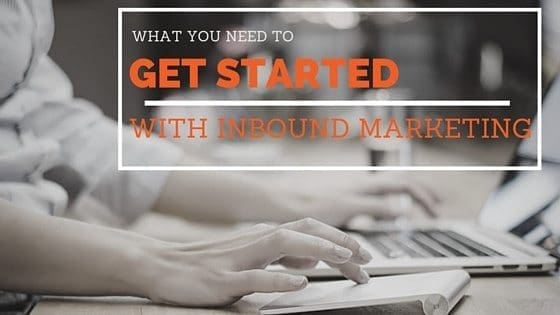
1. Get everyone in your company on board
This seems a little counter-intuitive. We’re talking about inbound marketing, so as long as the marketing team knows what they’re doing, we’re set, right? Unfortunately, this is the first mistake that nearly every single one of my clients has struggled with. Inbound marketing requires you to harness the collective expertise of your employees and you can’t do that without buy-in on at least some level from everyone at the company.
First, get your whole marketing team certified in inbound marketing. I recommend taking HubSpot’s Inbound Marketing Certification. You don’t need to have HubSpot to do it, it’s free, and it’s comprehensive. This will ensure your marketing team is on the same page and has a good foundation to build upon.
- Your marketers don’t have the knowledge that your sales reps or account managers have. They don’t know what customers say on a daily basis, they may not know the intricacies of the service or product you offer; but they will need to access that knowledge when creating content, and setting that expectation up ahead of time will save everyone from headaches and misunderstandings.
- Some of your client-facing employees may have a hidden talent – writing. If you know of anyone who is both an expert and a good writer, you’ve got a prime candidate for a regular publisher to your blog. This person doesn’t have to be in marketing at all, but if you give them the opportunity, they may turn out to be the best writer for your audience.
2. Create buyer personas (if you don’t already have them)
Many people think a buyer persona is a fancy term for “demographics” or your “perfect customer.” However, a buyer persona is deeper than that, and is an integral part of a successful inbound marketing strategy. A buyer persona is a fictional character representing the composite characteristics that make up a segment of your audience. This character has details that include demographic information, but also tells us what challenges or frustrations your audience faces, what their relationship to their boss is, what their leisure activities are, and so on. It gives you a full understanding of who your audience is. Here’s why buyer personas are so important:
Buyer personas tell you exactly who you’re writing for, why you’re writing it, what you should be writing, and how to present it.
If your company’s buyer personas can’t give you that information, you don’t have (complete) buyer personas. Our buyer personas are so detailed that we know where they go for news, how much time they take to read blogs, etc. That’s the power of it, right there. If you know what your audience’s pain points are, where they look to learn new things, and how they prefer digesting information, you’ll have a clear picture how where and how to give them the information they want.
3. Create campaigns (and a campaign process)
Campaigns are the heart and soul of your inbound marketing operations. They make sure everything you create is relevant to everything else, metrics are tracked in a more meaningful way, and make creating SMART goals easier.
Define your campaign
In marketing, what makes campaigns tricky is that there are many different definitions of what a campaign is. At Sensible, we define a campaign as a series of marketing tactics that have a similar tone and message and work together to achieve a goal. We run simultaneous campaigns that start at the beginning of a quarter and finish at the end. Our campaigns are created based on our buyer personas, and we have one campaign for each persona, each quarter. However, your campaigns may be based on an event, a theme, a content offer, or any other focal point you choose to use. The key is consistency in how you define your campaigns.
We decided to use buyer personas as our campaign focus because that way, we know we are creating content (blogs, offers, social media, webinars, etc.) that addresses our audience’s pain points. We decided to use a quarterly timeframe because it gives us time to A/B test, see what worked and what didn’t, and add content and fine tune the campaign for the following quarter.
What goes into a campaign?
Campaigns often consist of all of the marketing content you use, including inbound and traditional marketing tactics. Here are some examples:
- Email marketing
- Downloadable premium content offers
- Videos
- Social media
- Blogging
- Direct mail
- Paid advertising
- Webinars
- In-person events
Design the campaign
Let’s say you’re going to create a buyer persona-based campaign that will run for 3 months. Here are the steps you take to design your campaign:
- Set a goal: Set a SMART goal that you want to achieve with this campaign. An example of a SMART goal would be to get 50 new leads that fit into the buyer persona (in the 3-month time period).
- Figure out what will cause that goal to be reached: If you want 50 NEW leads, you’ll have to use marketing tactics to identify and attract people to the website that haven’t been there before, or people who have been but never converted. This goal might be accomplished using a combination of blogging, premium content offer(s), social media, and paid advertising.
- Create a content plan: Decide how often you will blog and what you will blog about; how many offers you will use and what you need to create from scratch; where you will be publishing to social media and how often; and where you’ll pay for paid ads, how much, and where the ads will lead to (hint: it’s to a landing page).To figure all this out, it will take some marketing best practices, and more importantly, your persona. Your persona will tell you what challenges and pain points you should address in your content, what the message and tone is, and where your audience spends their time online (especially important for social and paid). When the content plan is complete, you should have a list of all of the blogs that will be written, what the content offers are, where you will post on social (and how often), and where you’ll place your ads.
- Do the work!: Now that you have a plan and a goal, implement the plan and track it regularly. Are you on track to meet your goal? If not, try A/B testing your blog titles, try a different social media tactic or increase your paid ads budget. You’ll need to have a good way to track the metrics of each of these tactics, such as Google Analytics or Leadin (if you have a WordPress website).
4. Develop Processes
Once you’ve gone through your campaigns a couple of times, you should write down a step-by-step process of how to create a campaign. This will help new hires become productive more quickly, provide consistency in your campaigns, and make your entire marketing team more effective and efficient. But a campaign process is just one of many processes that your marketing team should develop. Processes are critical if you want to create a scalable system and get the best results. Here are just a few other examples of processes your team should have:
- Creating database emails
- Publishing to social media
- Responding to social media engagement
- Tracking and analyzing data
- Creating monthly/quarterly marketing reports
- Designing ebooks
- Writing/publishing blog posts
- Reviewing campaigns after completion
- Designing and hosting a webinar
- Updating the website
These processes are just for getting tasks done. There are processes for strategies and client relations that you can be using as well.
In my (nearly) four years of experience working with inbound marketing, I will tell you that it’s not easy and it’s not the magic bullet people tend to think it is. However, if you commit to it, create a good strategy and implement it well, then you will get amazing results and ROI time and again. These four steps will help you on your way to becoming an inbound marketing superstar.




